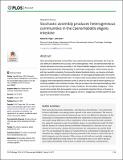Stochastic assembly produces heterogeneous communities in the Caenorhabditis elegans intestine
Author(s)
Vega, Nicole; Gore, Jeff
DownloadVega-2017-Stochastic assembly produces heterog.pdf (2.425Mb)
PUBLISHER_CC
Publisher with Creative Commons License
Creative Commons Attribution
Terms of use
Metadata
Show full item recordAbstract
Host-associated bacterial communities vary extensively between individuals, but it can be very difficult to determine the sources of this heterogeneity. Here, we demonstrate that stochastic bacterial community assembly in the Caenorhabditis elegans intestine is sufficient to produce strong interworm heterogeneity in community composition. When worms are fed with two neutrally competing, fluorescently labeled bacterial strains, we observe stochastically driven bimodality in community composition, in which approximately half of the worms are dominated by each bacterial strain. A simple model incorporating stochastic colonization suggests that heterogeneity between worms is driven by the low rate at which bacteria successfully establish new intestinal colonies. We can increase this rate experimentally by feeding worms at high bacterial density; in these conditions, the bimodality disappears. These results demonstrate that demographic noise is a potentially important driver of diversity in bacterial community formation and suggest a role for C. elegans as a model system for ecology of host-associated communities.
Date issued
2017-03Department
Massachusetts Institute of Technology. Department of PhysicsJournal
PLOS Biology
Publisher
Public Library of Science
Citation
Vega, Nicole M., and Jeff Gore. “Stochastic Assembly Produces Heterogeneous Communities in the Caenorhabditis Elegans Intestine.” Ed. Ken Cadwell. PLOS Biology 15.3 (2017): e2000633.
Version: Final published version
ISSN
1545-7885